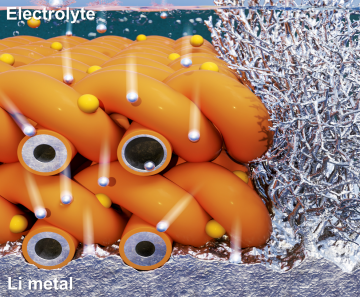KAIST
BREAKTHROUGHS
Research Webzine of the KAIST College of Engineering since 2014
Spring 2025 Vol. 24SUPPORT enables accurate optical readout of voltage signals in neurons

Voltage imaging, a technique for the optical measurement of electrical signals in neurons, shows promise for the future of neuroscience but is currently hindered by a low signal-to-noise ratio. SUPPORT, a newly developed self-supervised algorithm, overcomes this challenge by learning to denoise directly from noisy datasets.
Voltage imaging is a cutting-edge technique used in neuroscience to optically measure the electrical activity of neurons. This technique uses special fluorescent molecules that change their brightness in response to the electrical potential across a neuron's membrane, which makes the neuronal activity visible. However, one of the biggest challenges in voltage imaging is the low signal-to-noise ratio (SNR). The rapid changes in neuronal signals, occurring in milliseconds, demand high-speed imaging, which in turn reduces the number of photons available per frame, making it difficult to distinguish the signal from the noise.
Addressing this challenge, a research team at KAIST, led by Prof. Young-Gyu Yoon, has developed SUPPORT, an innovative self-supervised denoising algorithm that learns and utilizes spatiotemporal dependence among pixel values. SUPPORT enables precise denoising of voltage imaging data, greatly lowering the technological hurdles of voltage imaging without relying on assumptions that lead to statistically biased estimations. The algorithm assumes that the pixel value in voltage imaging data is dependent on its spatiotemporal neighboring pixels. Such a minimal assumption allows for the avoidance of statistical bias, thereby enabling accurate denoising.
SUPPORT's unique strength lies in its ability to learn directly from the dataset it is denoising, coupled with its minimal assumption regarding the dataset’s characteristics. As a result, the new algorithm excels in denoising various types of time-lapse fluorescence microscopy images, irrespective of the relative speed between the camera and the dynamics in the scene. Additionally, SUPPORT can significantly improve the SNR of volumetric structural imaging data, revealing structures previously obscured by noise. This enhancement is achieved by treating the z-axis (optical axis) as a temporal dimension in the dataset.
One of the key advantages of the self-supervised algorithm is the ability to enhance imaging quality without specific experimental setups or extra training data, making it a highly accessible tool for researchers globally. The team has also developed a user-friendly software interface, further broadening access to this sophisticated technology. As the neuroscience and bio-imaging communities delve deeper into understanding the brain and other complex biological systems, SUPPORT is a prime example of the synergistic potential of AI and scientific exploration. "The rapid adoption of SUPPORT by many researchers for processing their datasets is incredibly exciting," remarked Minho Eom and Seungjae Han, who spearheaded the development of this algorithm.
Their work is featured as the cover article of the October 2023 issue of Nature Methods, titled “Statistically unbiased prediction enables accurate denoising of voltage imaging data.”





Most Popular

When and why do graph neural networks become powerful?
Read more
Smart Warnings: LLM-enabled personalized driver assistance
Read more
Extending the lifespan of next-generation lithium metal batteries with water
Read more
Professor Ki-Uk Kyung’s research team develops soft shape-morphing actuator capable of rapid 3D transformations
Read more
Oxynizer: Non-electric oxygen generator for developing countries
Read more